

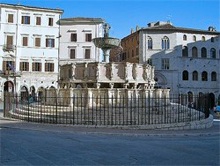
The Commune first began to plan the construction of a new aqueduct to bring water to the city from Montepacciano in 1254. The work made little headway until 1277, when a commission of enquiry advised that it should be executed by the Venetian hydraulic engineer, Boninsegna, who had experience of a similar project at Orvieto. The Commune accepted this advice, and simultaneously sought the permission of the Prior General of the Sylvestrine Order for the appointment of Fra Bevignate as “superstans fontis et operis conductus” (supervisor of the work on the fountain in Piazza Grande , that was to be fed by the aqueduct). He seems to have been extraordinarily effective, because the work was completed in 1278.
In 1277, Fra. Bevignate suggested the appointment of Arnolfo di Cambio for the sculpture on the fountain, and the Commune sought permission of King Charles d’ Anjou for his release from work in Rome. However, this could not apparently be arranged in time, and the work was given to the father and son Nicola and Giovanni Pisani (see below). Arnolfo di Cambio went on to design and decorate the Fontana Minore (1277-81).
A marble inscription on the lower basin of the Fontana Maggiore records the return of its water supply in 1322 after a period in which the aqueduct had been out of commission.
Upper Basin
The upper basin is cast in bronze and carries an inscription that translates:
"Rubeus made (i.e. cast) me in 1277, at the time of Podestà Geraldino dei Boschetti and Capitano del Popolo Anselmo di Alzate. Those responsible for the work were the Benedictine Fra. Bevignate and Boninsegna".
Another inscription at the base of the column that sustains the basin translates:
"At the time of Matteo da Correggio and Ermanno da Sassoferrato" (who were respectively Podestà and Capitano del Popolo in 1278).
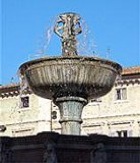
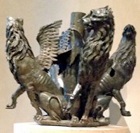
Middle Basin
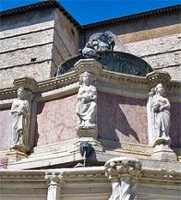
Water spills over from upper into the middle basin, which is formed from 24 slabs of pink stone from Bettona with marble figures at the junctions. Inscriptions above identify the figures. The three figures illustrated here (which face Corso Vannucci) personify Perugia and her dependent territories (see below).
The long inscription made up of five hexameters runs along the lower cornice. This identifies the roles of Fra. Bevignate, Nicola and Giovanni Pisani, and Boninsegna. The relevant sections translate:
-
✴City of Perugia, rejoice and remember as your father
-
good Fra. Bevignate, devoted to every wise undertaking.
-
He is the builder of this work, he directed all things.
-
We should praise him with the sweet name of [St] Benedict.
-
Capable of order, he has given us this work and is pleased.
-
✴These are the names of the excellent sculptors of the fountain:
-
Nicola, famous in this art, is appreciated in every work.
-
He is the flower of sculptors and most pleasing among the good.
-
He is the father, and the other is the most beloved son
-
.... who is named Giovanni.
-
Pisans by birth, may they long be healthy.
-
✴We know which celebrated mind brought in the waters:
-
he who ... is known as Boninsegna.
-
He executed the work and made all the piping.
-
He was born in Venice and is beloved by the Perugians.
The poem also records the completion of the work in 1278, at the time of Pope Nicholas III and the Emperor Rudolf I.
Lower Basin

Twelve spouts in the lower cornice of the middle basin conduct water into the larger lower basin, which is made of Carrara marble and decorated with 25 pairs of marble reliefs. Again, the subject of each is identified by a Latin inscription. The pair of reliefs illustrated here belongs to a series on the labours of the months: these two represent January and February.
Iconography
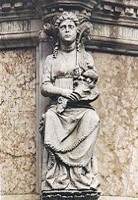
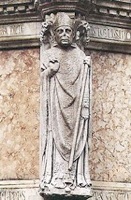
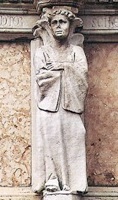
Perugia St Herculanus Traitor cleric
The iconography of the sculpture used on the fountain speaks of the civic pride of Perugia. In particular:
-
✴The personification of Perugia holding a cornucopia is flanked by a woman bearing a fish and another bearing a sheaf of corn, tribute from Perugian territories near Lake Trasimeno. (The second figure is sometimes referred to as a personification of Chiusi, but the inscription "Clusium" here more probably refers to the fertile Chiugi di Perugia, between Chiusi and the lake).
-
✴The fountain also depicts St Herculanus, the patron saint of the city, and (for reasons that are unclear) the deacon who betrayed him to Totila in 549.

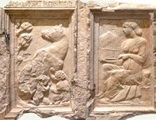
Rome Romulus and Remus suckled by a wolf
and their mother, Rea Silvia
-
✴The personification of Rome (on the middle basin, facing Palazzo Vescovile to the west) and the related pair of reliefs of Romulus and Remus and their mother Rea Silvia (on the lower basin - illustrated above, to the right) spoke of Perugia's allegiance to the papacy. These panels were damaged in the uprising of 1859 and replaced by copies during restoration in 1948: the originals (illustrated here) are in the Galleria Nazionale.
-
✴The statues also also include a figure of “Heulixstes” (Aulestes), the mythical founder of Perugia. (In 1293, the commune commissioned Bonicafio da Verona to write a chronicle of Perugia that covered its history from its foundation, in the form of a poem in nine books and an accompanying prose version. The former is usually known as the “Eulistea”).
Read more:
B. Dozzini, “Main Fountain of Perugia” (1994) Assisi, which includes the translations of the inscriptions given above.
M. Battisti, "Per una Revisione del ‘Problema Fra’ Bevignate’: l’ Attività Perugina e Orvietana", Bollettino Istituto Storico Artistico Orvietano, 42-3 (1986-7) 83-108.
Return to Monuments of Perugia.
Return to Walk I.

